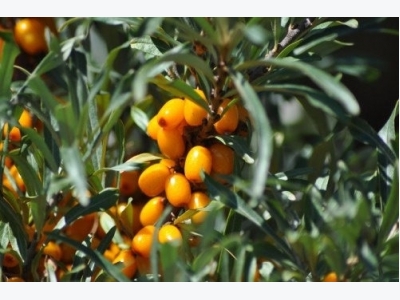How to Grow Sea Berry

Sea berry, also known as sea buckthorn (Hippophae rhamnoides), is a hardy perennial shrub with silvery green leaves that produces a highly nutritious berry packed with vitamins and antioxidants.
While the sea berry plant has been a bit overlooked here in the U.S. until recently, this resilient bushy plant is an up and comer. It is a tough, undemanding, cold tolerant beauty that offers a sweet treat to boot.
The sea berry bush is native to Russia, Asia, and Europe and has long been known in these locations for the benefits of its growth. The sea berry has been used as a natural resource for thousands of years. It has been planted to prevent soil erosion and also to support economy for its nutritional and medicinal value.
The sea berry plant can be grown in mountainous areas, in semi-desert locations and near the sea. It thrives in U.S. Department of Agriculture Hardiness Zones 2 to 9. In the wild, it is often found near coast lines where other large plants cannot survive. The sea berry has the unique ability to tolerate salinity in soil.
Planting sea berry
Planting a sea berry is simple. Plant your sea berry in full sun in the spring. The sea berry is not picky when it comes to soil condition, but it does enjoy well-draining, moist ground. Water regularly to ensure your plant doesn't dry out. Feed your sea berry bush once a year with an organic mix.
If you would like to enjoy sea berry fruit, plant at least one male and one female plant. One male plant can pollinate up to five female plants. Pollination occurs with wind, so place your plants 3 to 6 feet apart. Your sea berry plants will grow to between 6 and 18 feet tall and will produce fruit by the fifth year at the latest.
While the sea berry bush does not require pruning, it is a plant that allows you a bit of creativity. You can prune the plants into hedges, into bushy shrubs, or even into trees. If you don't feel like forcing any shape to your sea berry bush, occasionally take the time to trim off unproductive or damaged branches.
Harvesting the clustering berries from this thorny plant is difficult but not impossible. Pick the fruit when it is ripe during the late summer and early fall. Look for full, uniform color and firmness. The berries will most likely be tart and acidic. You may enjoy the flavor, but if not, try sweetening them up with sugar or honey.
The berries are ideal in jelly and juice. After picking and cleaning the berries, process them promptly to maintain freshness. They can be stored in the refrigerator for up to 2 weeks. The berries can also be flash frozen. Spread the berries in a single layer on a cookie sheet and place them in the freezer. Once frozen, they can be stored if freezer bags in usable portions. The leaves of the sea berry fruit can be dried and used for a tasty tea.
Sea berry pests and problems
Not a problem for most, but a possible agitation to some, the sea berry plant attracts a variety of birds for nesting purposes. While the birds enjoy the thorny protection of the sea berry branches, they do not have an affinity for the fruit. Fortunately, you will not have to compete for your harvest.
Sea berry cultivars to consider
'Russian Orange' is a less thorny variety and yields large, good quality fruits.
'Sirola' is a strong, vigorous grower that is only slightly thorny. The berries of this variety are pleasantly sweet.
'Hergo' is a tough variety with high harvest potential.
Related news
 How to Grow Virginia Bluebells
How to Grow Virginia Bluebells Bluebells were used medicinally by the Cherokee Indians to treat tuberculosis and whooping cough and as an antidote for poisoning.
 How to Grow Mountain Laurel
How to Grow Mountain Laurel The mountain laurel (Kalmia latifolia) is a medium-sized evergreen bush also known as calico bush or ivybush.
 How to Grow Hawthorn Trees
How to Grow Hawthorn Trees Hawthorn trees (Crataegus) are small, versatile trees that make good substitutes for other more commonly grown trees, such as crabapples.